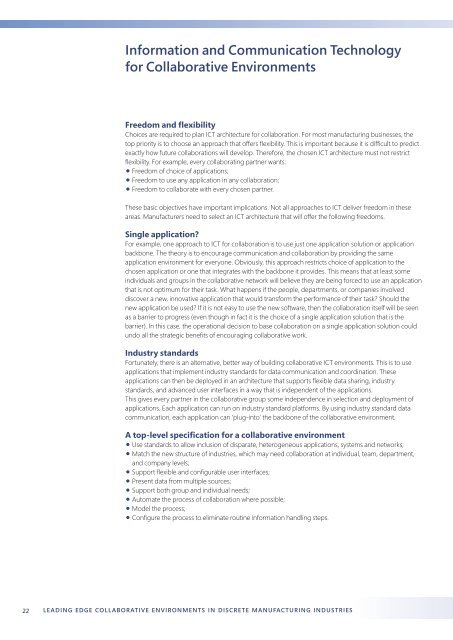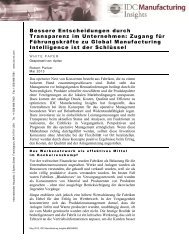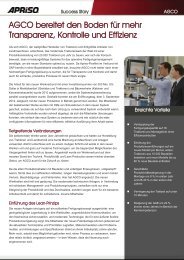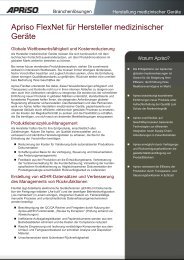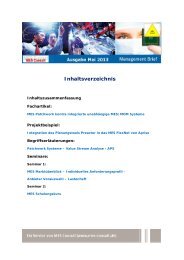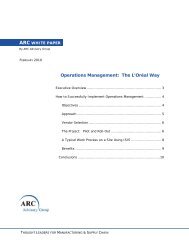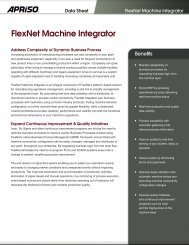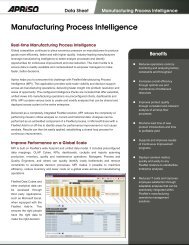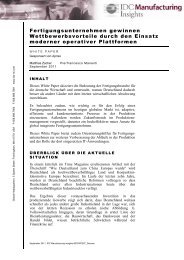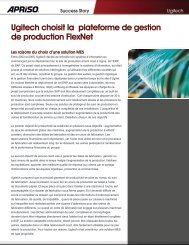Collaboration - Apriso
Collaboration - Apriso
Collaboration - Apriso
Create successful ePaper yourself
Turn your PDF publications into a flip-book with our unique Google optimized e-Paper software.
22<br />
Information and Communication Technology<br />
for Collaborative Environments<br />
Freedom and flexibility<br />
Choices are required to plan ICT architecture for collaboration. For most manufacturing businesses, the<br />
top priority is to choose an approach that offers flexibility. This is important because it is difficult to predict<br />
exactly how future collaborations will develop. Therefore, the chosen ICT architecture must not restrict<br />
flexibility. For example, every collaborating partner wants:<br />
• Freedom of choice of applications;<br />
• Freedom to use any application in any collaboration;<br />
Freedom to collaborate with every chosen partner.<br />
•<br />
These basic objectives have important implications. Not all approaches to ICT deliver freedom in these<br />
areas. Manufacturers need to select an ICT architecture that will offer the following freedoms.<br />
Single application?<br />
For example, one approach to ICT for collaboration is to use just one application solution or application<br />
backbone. The theory is to encourage communication and collaboration by providing the same<br />
application environment for everyone. Obviously, this approach restricts choice of application to the<br />
chosen application or one that integrates with the backbone it provides. This means that at least some<br />
individuals and groups in the collaborative network will believe they are being forced to use an application<br />
that is not optimum for their task. What happens if the people, departments, or companies involved<br />
discover a new, innovative application that would transform the performance of their task? Should the<br />
new application be used? If it is not easy to use the new software, then the collaboration itself will be seen<br />
as a barrier to progress (even though in fact it is the choice of a single application solution that is the<br />
barrier). In this case, the operational decision to base collaboration on a single application solution could<br />
undo all the strategic benefits of encouraging collaborative work.<br />
Industry standards<br />
Fortunately, there is an alternative, better way of building collaborative ICT environments. This is to use<br />
applications that implement industry standards for data communication and coordination. These<br />
applications can then be deployed in an architecture that supports flexible data sharing, industry<br />
standards, and advanced user interfaces in a way that is independent of the applications.<br />
This gives every partner in the collaborative group some independence in selection and deployment of<br />
applications. Each application can run on industry standard platforms. By using industry standard data<br />
communication, each application can ‘plug-into’ the backbone of the collaborative environment.<br />
A top-level specification for a collaborative environment<br />
• Use standards to allow inclusion of disparate, heterogeneous applications, systems and networks;<br />
• Match the new structure of industries, which may need collaboration at individual, team, department,<br />
and company levels;<br />
• Support flexible and configurable user interfaces;<br />
• Present data from multiple sources;<br />
• Support both group and individual needs;<br />
• Automate the process of collaboration where possible;<br />
• Model the process;<br />
Configure the process to eliminate routine information handling steps.<br />
•<br />
LEADING EDGE COLL ABORATIVE ENVIRONMENTS IN DISCRETE MANUFACTURING INDUSTRIES


